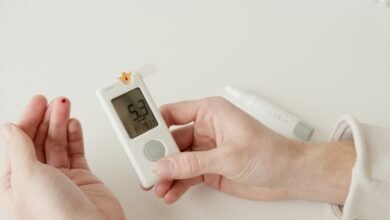How to Improve Circulation and Prevent Heart Disease
How to Improve Circulation and Prevent Heart Disease Maintaining a healthy circulatory system is essential for overall well-being. Good circulation ensures that oxygen and nutrients are effectively delivered to every part of the body. Poor circulation, on the other hand, can lead to various health issues, including fatigue, cold extremities, and more seriously, heart disease. If you’re wondering how to improve circulation and prevent heart disease, this article is your comprehensive guide. We will cover lifestyle changes, dietary tips, exercises, and proven strategies to enhance blood flow and support cardiovascular health.

Why Circulation Matters
The circulatory system is responsible for transporting blood, oxygen, and nutrients throughout the body. When circulation is compromised, your organs, tissues, and muscles can’t perform optimally. This can lead to several health problems, including heart-related diseases. Knowing how to improve circulation and prevent heart disease should be a priority for everyone—especially with rising cases of cardiovascular issues globally.
Signs of Poor Circulation
Before learning how to improve circulation and prevent heart disease, it’s important to recognize the signs of poor blood flow:
- Cold hands and feet
- Tingling or numbness in extremities
- Fatigue and low energy
- Slow healing of wounds
- Varicose veins
- Leg cramps
If you’re experiencing any of these symptoms, it may be time to make some lifestyle adjustments.
1. Stay Physically Active
One of the best ways to improve circulation and prevent heart disease is through regular physical activity. Exercise helps the heart pump blood more efficiently and keeps the arteries flexible.
Top Exercises to Improve Circulation
- Walking: Increases blood flow and reduces stress
- Swimming: Enhances cardiovascular endurance
- Cycling: Boosts heart rate and circulation
- Yoga: Promotes relaxation and improves blood flow
Aim for at least 30 minutes of moderate activity five times a week. Staying active is a powerful strategy for those wanting to know how to improve circulation and prevent heart disease effectively.
2. Eat a Heart-Healthy Diet
Diet plays a major role in your circulatory and cardiovascular health. Consuming foods that support heart function and blood flow is critical if you want to know how to improve circulation and prevent heart disease naturally.
Foods That Help
- Leafy Greens: Rich in nitrates which promote blood vessel dilation
- Berries: Contain antioxidants that reduce inflammation
- Fatty Fish: High in omega-3 fatty acids
- Citrus Fruits: Improve endothelial function
- Nuts and Seeds: Packed with healthy fats and magnesium
Incorporate these into your daily meals and limit processed foods, excessive salt, and sugar.

3. Stay Hydrated
Water is vital for healthy blood circulation. Dehydration thickens the blood, making it harder for the heart to pump. Knowing how to improve circulation and prevent heart disease includes remembering to drink enough water every day. Ideally, consume at least 8 cups of water, more if you’re active.
4. Quit Smoking
Smoking is one of the biggest contributors to heart disease. It damages blood vessels, restricts blood flow, and increases the risk of clotting. If you’re serious about learning how to improve circulation and prevent heart disease, quitting smoking must be a top priority. Support groups, nicotine replacement therapy, or counseling can be helpful in this journey.
5. Manage Stress Effectively
Chronic stress leads to high blood pressure and inflammation—two major risk factors for heart disease. To learn how to improve circulation and prevent heart disease, incorporate relaxation techniques into your daily life.
Stress-Relief Techniques
- Meditation
- Deep breathing exercises
- Journaling
- Spending time in nature
- Listening to calming music
Even 10 minutes a day of mindful activity can make a difference.
6. Maintain a Healthy Weight
Excess body fat, especially around the abdomen, increases the strain on your heart. It also contributes to high blood pressure and cholesterol levels. If you’re looking for long-term strategies on how to improve circulation and prevent heart disease, losing even 5-10% of your body weight can yield significant benefits.

7. Get Regular Checkups
Regular health screenings are important to detect potential issues early. High blood pressure, high cholesterol, and diabetes often show no symptoms but can lead to poor circulation and heart disease. If you’re committed to understanding how to improve circulation and prevent heart disease, keep track of your numbers and consult your doctor regularly.
8. Limit Alcohol Consumption
While moderate alcohol may have some cardiovascular benefits, excessive intake can harm your heart and blood vessels. Knowing how to improve circulation and prevent heart disease means finding the right balance. Stick to the recommended guidelines: up to one drink a day for women and two for men.
9. Elevate Your Legs
Sitting or standing for long periods can cause blood to pool in your lower limbs. Elevating your legs occasionally throughout the day can help improve venous return and reduce the risk of blood clots. This simple act is part of how to improve circulation and prevent heart disease, especially for people with sedentary jobs.
10. Wear Compression Garments
Compression socks and sleeves can support circulation by applying gentle pressure to your legs and arms. They help move blood back toward the heart, which is particularly helpful if you suffer from varicose veins or are on your feet all day. These small changes are part of the larger goal of how to improve circulation and prevent heart disease.
11. Incorporate Natural Supplements
Certain supplements can assist in enhancing blood flow and supporting heart health. Talk to your healthcare provider before starting any new supplement, but here are some commonly used ones:
- Omega-3 fatty acids
- Garlic extract
- L-arginine
- Coenzyme Q10 (CoQ10)
Including these in your daily routine is another method of how to improve circulation and prevent heart disease naturally.

12. Reduce Sodium Intake
A high-sodium diet can increase blood pressure, putting extra strain on your heart and arteries. Reducing salt intake is a foundational step in learning how to improve circulation and prevent heart disease. Opt for herbs and spices instead of salt when cooking.
13. Improve Your Sleep
Sleep is a critical yet often overlooked factor in cardiovascular health. Poor sleep contributes to hypertension and inflammation. Prioritizing sleep is a direct way of learning how to improve circulation and prevent heart disease. Aim for 7-9 hours of quality sleep each night.
14. Avoid Prolonged Sitting
Sitting for long hours at work or during travel can slow down your circulation. Get up and move every hour. Stretching, walking around, or doing a few squats can keep your blood flowing. It’s another simple but effective way on how to improve circulation and prevent heart disease.
15. Monitor Your Blood Pressure
High blood pressure is a silent killer and a major cause of heart disease. If you want to know how to improve circulation and prevent heart disease, you must regularly monitor your blood pressure at home or during doctor visits.

Final Thoughts
Heart disease remains one of the leading causes of death globally, but the good news is that it’s largely preventable. Understanding how to improve circulation and prevent heart disease empowers you to make lifestyle changes that have lasting impacts. Whether it’s eating better, staying active, reducing stress, or managing weight, each step you take contributes to a healthier heart and better circulation.
Don’t wait for symptoms to appear. Begin today by incorporating these habits into your daily routine. Knowing how to improve circulation and prevent heart disease isn’t just about living longer—it’s about living better. You can also see the related topics on https://healthneno.com/



